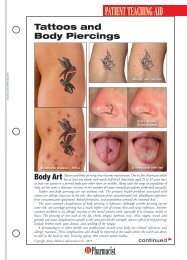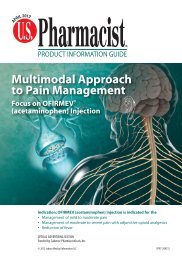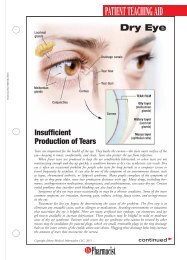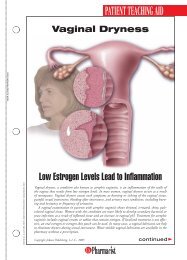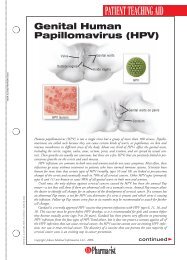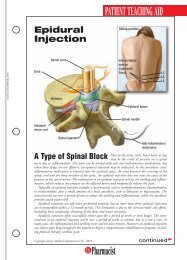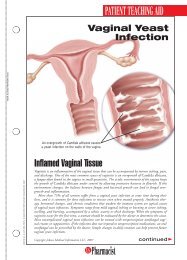View PDF Edition - U.S. Pharmacist
View PDF Edition - U.S. Pharmacist
View PDF Edition - U.S. Pharmacist
You also want an ePaper? Increase the reach of your titles
YUMPU automatically turns print PDFs into web optimized ePapers that Google loves.
OPIOID MAINTENANCE TREATMENTTable 1Comparison of Opioid Withdrawal ProfilesDose Equivalent to Time for Effects Onset of Peak of End ofDrug Methadone 1 mg to Wear off Withdrawal Withdrawal WithdrawalFentanyl 0.01 mg 1 h 3-5 h 8-12 h 4-5 daysMeperidine 20 mg 2-3 h 4-6 h 8-12 h 4-5 daysOxycodone 1.5 mg 3-6 h 8-12 h 36-72 h ≈7-10 daysHydromorphone 0.5 mg 4-5 h 4-5 h 36-72 h ≈7-10 daysHeroin 1-2 mg 4 h 8-12 h 36-72 h 7-10 daysMorphine 3-4 mg 4-5 h 8-12 h 36-72 h 7-10 daysCodeine 30 mg 4 h 8-12 h 36-72 h ≈7-10 daysHydrocodone 0.5 mg 4-8 h 8-12 h 36-72 h ≈7-10 daysMethadone NA 8-12 h 36-72 h 96-144 h 14-21 daysNA: not applicable.Source: Reference 6.used medication in opioid treatment programs. Accessto methadone for the treatment of opioid dependenceis available only through DEA-licensed methadoneclinics. LAAM is no longer being produced or marketedbecause of the increased risk of cardiac death.Clinical Pharmacology: Both methadone and LAAMare synthetic mu-opioid receptor agonists, like heroin,and serve to replace heroin or other opioids’ occupationof mu-opioid receptors. Methadone also is an N-methyl-D-aspartate antagonist.Methadone is a highly fat-soluble drug that israpidly and extensively absorbed. The oral suspensionhas variable bioavailability (range 36% to 100%) andreaches its peak effects 1 to 7.5 hours after intake. 11Methadone is a 50:50 racemic mixture. The R-enantiomerhas a significantly higher affinity to mu and kappareceptors. Methadone has an average half-life of 24 hours(range 13 to 50 hours). Metabolism of the drug occursthrough the CYP450 system—mainly CYP3A4, but alsoCYP2B6, CYP2C9, CYP2C19, and CYP2D6. Methadoneis an inhibitor of CYP2D6. 12,13Dosing: In an opioid-naïve patient beginning methadonemaintenance, the first dose should not exceed 40 mgowing to the risk of death from respiratory depression.A common starting dose is 20 mg to 30 mg. Thepatient usually is monitored for 2 to 4 hours to allow themethadone to peak. After the first day, additional dosesof 5 mg to 10 mg may be given if withdrawal symptomspersist. The dose may be slowly titrated over thenext couple of weeks to achieve a dose that prevents withdrawaland drug cravings without oversedating or causingother side effects. Most patients can be maintainedon a dose of 60 mg to 120 mg, although some patientswill need doses outside this range. 6For maintenance, methadone should be dispensed tothe patient as a 1-mg/mL solution. Doses of less than50 mg/day have been associated with increased relapserates and less retention in programs. 14,15Side Effects: Because methadone acts upon central opioidreceptors, its side-effect profile mirrors that of otheropioids. These effects include sweating, somnolence, dizziness,mild nausea, anorexia, constipation, and pruritus.The most serious adverse effects are respiratory depressionand cardiac arrhythmias. There also have been reportsof increased risk of cardiac death. Patients should becounseled regarding possible weight gain, sexual dysfunction,and oligomenorrhea or amenorrhea. 10,14Interactions: There are numerous potential drug interactionswith methadone (see TABLE 3). Methadone’s druginteractions occur primarily through inhibition or inductionof liver enzymes and changes in protein binding. 12,13No clinically significant protein-binding drug interactionhas been reported.Giving methadone with opioid antagonists, mixedagonist/antagonists, and partial agonists (i.e., naloxone,naltrexone, pentazocine, nalbuphine, butorphanol, andbuprenorphine) may precipitate withdrawal. Somnolenceand respiratory depression may be potentiated if methadoneis taken with other opioids.Buprenorphine and NaloxoneSome of the drawbacks of methadone treatment arethat the drug has increased risks of respiratory depression,death from overdose, QT prolongation, divergence,and difficult withdrawal. Buprenorphine is a partial agonistthat carries fewer risks than methadone. 16 Naloxoneis formulated in combination with buprenorphineto decrease the abuse potential: When taken correctlysublingually, naloxone has no clinical effect because ofpoor bioavailability; if injected, however, naloxone precipitateswithdrawal.Pharmacology: Buprenorphine is a synthetic opioid withpartial mu-opioid receptor agonism and kappa-receptorantagonism. It has a higher affinity for mu-opioid receptors;therefore, it displaces morphine, methadone, andother full agonists from the receptor site. This partial41U.S. <strong>Pharmacist</strong> • November 2009 • www.uspharmacist.com




